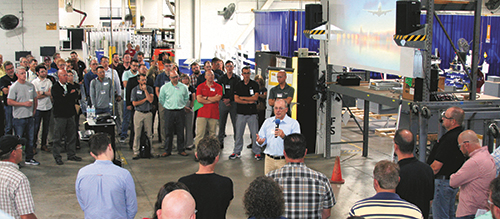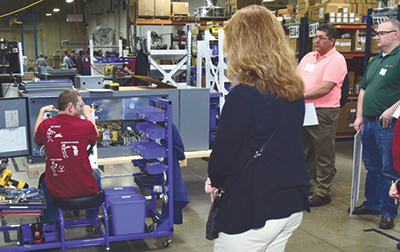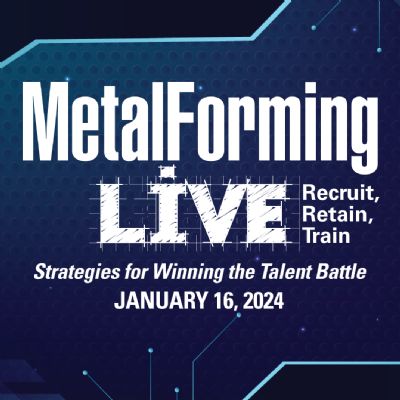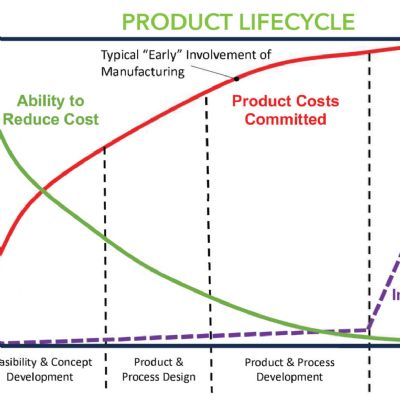 Lea Tonkin
Lea TonkinGrowing and Engaging People Every Day in Lean
August 1, 2018Comments
Known for its heating and ventilation products and strong family culture, Cambridge Engineering, Inc. is reaping the benefits of its lean journey. However, like with most company-altering strategies, adjustments were necessary in order for lean to take hold at the Chesterfield, MO-based manufacturer.
When John Kramer Jr., chair and CEO, recognized lean as a logical next step for Cambridge Engineering 10 years ago, experts advised starting with 5S improvement projects, training workforce on Japanese terms, and then adding a host of metrics and white boards—adding to the mix of daily priorities. It was top-down driven and tolerated, not embraced, by the company’s 120 employees.
Cambridge Engineering chair and CEO, John Kramer Jr., addresses a benchmarking tour group. Since 2015, Cambridge Engineering has hosted more than 200 companies.
“There were too many metrics, and there was too much focus on cost rather than on people,” Kramer notes. “Our busy season (fall through January) would hit, and I would tell my people to stop improvements and ship products. All of our lean principles would go out the window, as people did not have time to make improvements. Although I had a glimpse of the vision of a lean culture, many times it felt like we were going backward rather than forward.”
Staying Focused
After working with an executive coach and following the plan for organizational health described in Patrick Lencioni’s book, The Advantage, Kramer determined that his leadership was the biggest challenge and barrier to making the cultural changes he envisioned. “I would whipsaw the organization in a million directions without giving employees the chance to make progress,” he says. “Once I stopped and allowed the team to focus on key areas for success and develop a rhythm and pace, the cultural progress started to come alive.”
During this period of growth, operational team members came back after a lean benchmarking trip to FastCap, lean expert Paul Akers’ facility in Washington state. “They were excited about his book, 2 Second Lean,” Kramer says. “They had met with Paul and learned that you can improve and prosper by taking something complex and making it simple. We started making simple changes and celebrating small improvements, opening up more dialog with our employees. The concept, embraced by our organizational leadership, also resonated with our executive team members and me because it focused on people growth and engagement. Because it was so simple to understand and was people-focused, the team was able to quickly share with others inside the company, and we haven’t looked back since.”
Akers strongly encourages readers to start their lean journey by learning to see waste, allowing people to “fix what bugs them,” and then to make short videos for sharing improvements with others.
“I remember how excited our leaders became about the concepts taught in 2 Second Lean. Their courage to try something new and experiment with videos was amazing,” says Marc Braun, president, who was the executive vice president of sales and marketing at the time. “Our marketing department had used video sparingly. We had a collection of several videos reflecting the ‘Cambridge Story,’ and little presence on YouTube. The company now has more than 4300 videos created by employees.”
Every employee is encouraged to make 1-min. videos. Some are accounts of rapid changes to eliminate wasted steps or prevent over-reaching at a workstation. Other videos reflect improvements over an extended period.
Ideas, Processes and Products
“For us, lean is about people and people growth,” says Greg Sitton, plant manager. “It’s not something that is simply implemented.” Key elements in creating lean understanding include lean classes for all new hires using 2 Second Lean as a guide, and then taking them out to the shop floor and asking them to stand there and look for the eight types of waste. “Within 10 minutes, they typically see 20 to 50 wastes,” Sitton says.
The company also gives employees time on the clock to read 2 Second Lean and to discuss the book in a team setting, encouraging employees to “go and see” waste and to develop remedies for eliminating waste in their work areas. This expectation reflects a significant transition from Cambridge’s initial lean efforts, when senior leaders and engineers usually initiated lean improvements.
“That idea only works for owners of the company,” says Sitton. “We realized that we needed more people who buy into the culture. Now we develop people with a sense of trust, who are able to see waste and fix what’s bugging them, and they now respond as owners.”








 Podcast
Podcast
 Webinar
Webinar